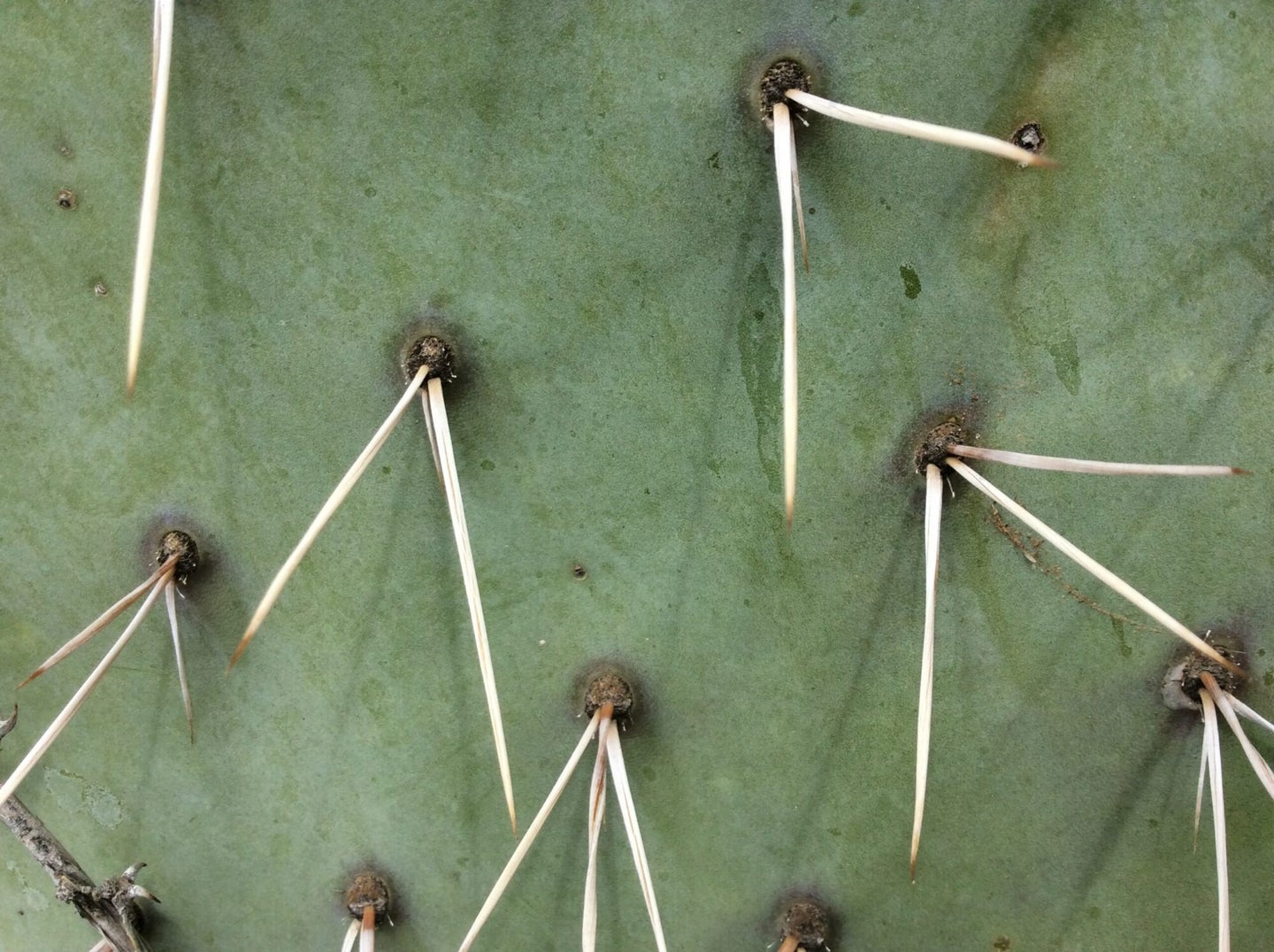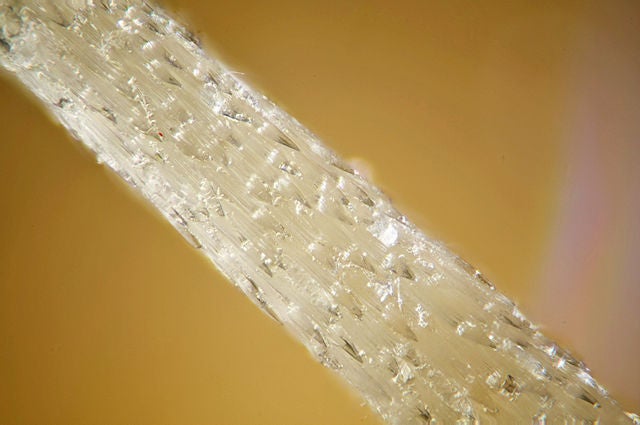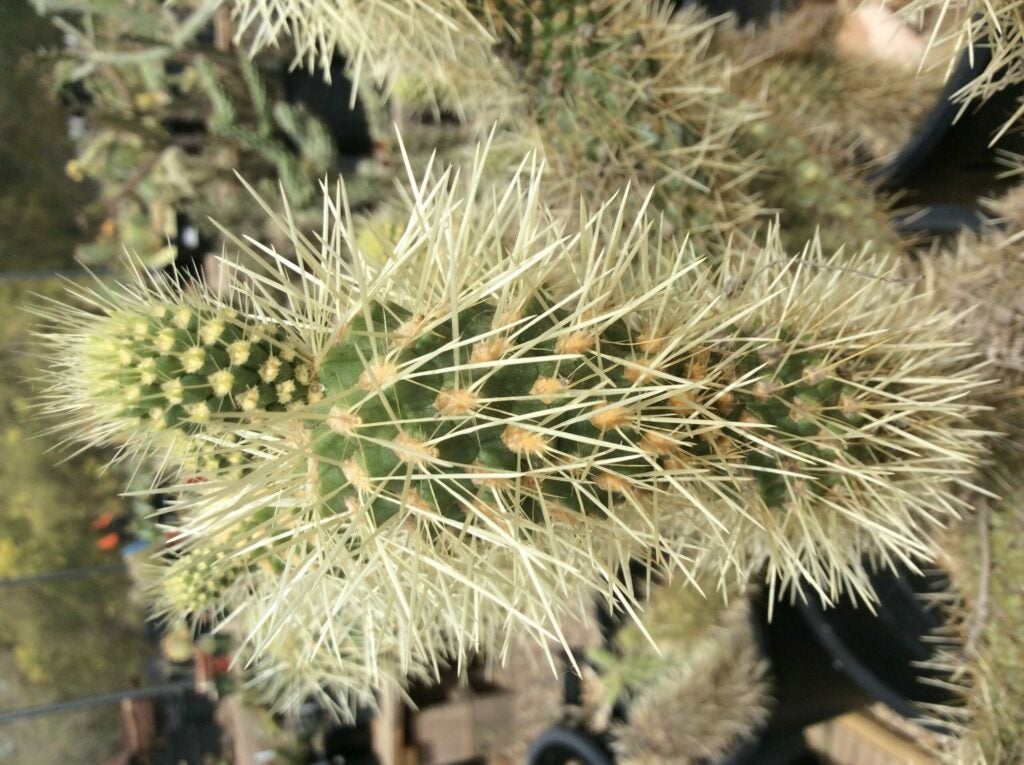
Raul Puente-Martinez has been pierced by quite a number of cactus needles in his time. A research botanist and curator of living collections at the Desert Botanical Garden in Phoenix, he’s been studying prickly pears and chollas, which are infamous for their barbed spines, for decades. However, the worst cholla attack he’s ever witnessed came while he was hiking with several friends in Mexico. As they strolled through a cholla forest, one of the group members discovered a chunk of cactus stuck to the tip of his shoe. He tried kicking his foot out to dislodge the spiny hitchhiker. Sure enough, most of the cactus flew off—including one piece that shot straight up and became stuck in the man’s upper lip.
Luckily, Puente-Martinez has had a lot of practice figuring how to remove cactus needles from different body parts. “You could see that they were really deep inside his lip,” he recalls. “Every time I pulled one, there was this little stream of blood coming out of the hole; that was pretty bad.”
Most encounters with cacti aren’t quite that harrowing. But the plants are ubiquitous in some parts of the desert, and are also highly popular (and useful) as home decor. They’ve evolved a wide variety of spines to thrive in the unforgiving desert and some can snare you more easily than others. They can also cause painful complications. So it’s a good idea to prepare yourself for a cactus crisis. Luckily, Puente-Martinez and several other experts can offer a number of tips on how to remove cactus needles based on their hard-won experience.
1. Understand how cactus needles work
Cactus needles make a pretty great armor, but they aren’t just there to stab you. These fibrous structures, which are derived from leaves, do a range of other jobs as well. A coating of spines can serve as shade by day or insulation by night. They can also diffuse light similarly to a photography umbrella, says John Trager, curator of desert collections at the Huntington Botanical Gardens in San Marino, California. This ensures that light is distributed over the plant’s entire surface, even if it is growing in a shady spot. Cactus spines collect water too. Some are curved downwards so that any water that condenses on them will drip onto the soil around the roots, while a few have a cork-like texture that absorbs water.
And spines can camouflage a cactus from hungry animals, as with the flattened, twisted spines of the paperspine fishhook cactus that resemble blades of grass. Cactuses are so good at blending in with their surroundings that people sometimes fail to notice them while they are out hiking, Trager says. “Depending on the lighting, you might not recognize that it’s a spiny as it is until you feel it.”
For chollas and prickly pears, spines serve another purpose that makes them especially unpleasant to tussle with. Unlike the pillar-like saguaro or barrel cactus, these species are built from a collection of smaller pieces that are easily snapped off. “Each one of those portions of the stem has the ability to root in the ground and start a new plant,” Puente-Martinez says. “That ability to propagate and disperse like this, that is what has made them so successful in the desert.”
Spines are a key part of this strategy since they allow a cholla or prickly pear pad to snag passing animals. “They might break off a piece of that cactus and then they will drop it somewhere else,” Puente-Martinez says.
[Related: How to not get pricked by a North American porcupine]
The spines of these cactuses are designed to catch hold of anything that comes in range, including you. “They’re often viciously barbed,” Trager says. “The so-called jumping cholla doesn’t really jump, but once it catches onto you the barbed spines stay put.”
The barbs on these spines resemble a line of fishhooks, says Park Nobel, an emeritus professor of biology at the University of California, Los Angeles, and coauthor of The Cactus Primer and several other books on cactuses and agaves. “So if the spine sticks in, any movement of the unfortunate animal makes the spines go further and further into the tissue, thereby encountering more barbs and making movement even more difficult,” Nobel said in an email.
To make matters worse, chollas and their relatives also sport fine, hair-like spines called glochids. Some of them, such as the bunny ears cactus that is native to Mexico, have glochids but lack regular spines, giving them a more harmless appearance. Don’t fall for it. Glochids are barbed and even trickier to remove than larger spines. “They look soft and fuzzy at first glance,” Trager says. “You might be tempted to pet it or touch it and you get a fistful of these little itchy spines.”

2. Assess if the injury is dangerous
You’re extremely unlikely to die from getting speared by cactus spines, but they can do some damage. Puente-Martinez says this is especially true if you stumble and fall on top of them, as very occasionally happens when people attend receptions at the garden and get tipsy.
The spines can also wind up in more sensitive areas after the initial attack. “If you touch that cactus and now you rub your eye or you put your finger in your mouth, if you have those little barbs or those glochids in there, then you really can have a problem,” says Raymond Dieter, a semi-retired cardiothoracic surgeon who volunteers his services at the Tri City Health Partnership Medical and Dental Clinic in St. Charles, Illinois. “Even though you may be stuck in your knee, they might end up someplace else in your body.”
Sometimes, the barbs can painfully irritate the skin or cause an infection. Such was the case for a young woman Dieter and his colleagues encountered who tripped and fell on a cactus while getting up from dinner. It was not long before swelling and redness had set in, says Dieter, who published a study on the incident in the journal Wounds. This reaction can lead to pustules that last for months and can result in little black spots of dead skin that need to be cut out. In some cases, the wound may become infected with the bacteria that cause staph infections or gas gangrene.
That’s not the most likely outcome, though. “Most people are going to do okay,” Dieter says. “They’ll get over it in a few days or a week or two, but in some people it goes on a long time.” Putting a cold pack on your skin right after you’ve been pricked may lessen the severity of the reaction, he adds.
3. Methodically remove the big and small cactus needles
First of all, don’t grab the spines. “It’s a natural reaction,” Dieter says. But “you’re better off not to use your fingers if you can avoid it.”
It’s all too easy to make a bad situation worse, particularly if you try to pull off pieces of cholla with your bare hands. Nobel once saw the aftermath of this decision in a couple in Saguaro National Forest who had fallen victim to the notorious teddy bear cholla. Initially, one of the pair had become stuck on a piece of stem, and when his wife tried to free him, she too was snared.
“The more they struggled the deeper the spines went,” Nobel says. “They were screaming for help walking along the road in an unnatural embrace, holding hands with the tortuous joint.” Nobel was able to free the pair by cutting the spines out with a pair of wire cutters.
Puente-Martinez also recommends removing the chunk of stem the spines are attached to before dealing with the individual prickers, as he did on the occasion in Mexico when his friend’s lip became a pincushion. Use a pair of scissors or pliers to clip the spines attached to the stem, leaving about half-inch segments of spine behind in your skin, he advises. You can also use the teeth of a comb to work the stem and some of the spines free. If the spines are embedded in your hand and you don’t have any tools handy, you can also try bending over, stepping on the stem joint, and tugging your hand free, although this will likely cause a bit more bleeding as the spines are pulled away.
[Related: First aid basics for your adventure in the wilderness]
What you should do next depends on the kind of spine you’re dealing with. You can try working larger needles out with a pair of tweezers. The straight spines found on cactuses like the saguaro are the easiest to pull free, while barbed cholla spears or hooked spines like those found on barrel cactuses will unsurprisingly take a little more work.
Cactus spines will often break when you try to remove them, leaving pieces lodged under the skin. “You’ll know if you haven’t gotten it all because [the area] will remain sensitive to the touch,” Trager says.
You can try digging around with tweezers or a needle to excavate the spine fragment, but they can be translucent and hard to discern. “Often you’ll do more damage trying to poke around with a needle than the spine itself did,” Trager says. “Unless you can actually see the broken base of the spine just under the skin or something it might not be worth doing it.” Soaking in a warm bath with Epsom salt can relieve some of the pain from embedded spines, he says.
The tiny glochids are particularly tricky to remove, and it’s easy to end up with dozens or more stuck in your skin if you touch a cholla or related cactus. When Puente-Martinez finds himself in this situation, he likes to soften the tiny barbs by running the afflicted limb under warm water. He then scrapes the bristles off with a knife, although this technique can leave the tips behind in your skin. “They’re going to bother you for awhile,” he admits. He’s found that tiny tweezers such as those that come with a Swiss Army Knife are ideal for plucking stubborn glochids; the larger tweezers that many people keep in their bathrooms seem to be less suited for grasping the tiny prickles. A magnifying glass comes in handy for this work, too. You can also use something sticky like duct tape to tug the barbs out of your skin.
If you can’t get all the spines or barbs out, don’t worry. In most cases, they will disintegrate inside your body or eventually be pushed out.

4. Avoid further contact with the splinters
Puente-Martinez himself has been known to use his teeth to remove spines when he doesn’t have any other tools handy. But you really shouldn’t. Remember that painful reaction that the glochids can sometimes bring on?
“Let’s just say you’ve hit a cactus with your wrist or your arm, and you reach down with your mouth to pull [the spine] out and spit it out,” Dieter says. “You might get the spine, but the glochid might then stick in your tongue, or in your lip, and then you’re going to have that reaction in your mouth or in your lip and you won’t be a happy camper.”
Another painful possibility is that the barb will embed itself in your throat, which is exactly what once happened to Puente-Martinez (and is the reason why he strongly recommends you do not try this method at home, or ever). He had gently grabbed the spine with his teeth and was just about to spit it out when one of the people working on the plants nearby asked him a question.
“I turned around and swallowed the little glochid,” he says. “I had it there for a couple of days; it was really bothering me.” He finally dislodged the glochid by chewing bread. His theory is that as your saliva moistens the blob of bread, it becomes sticky enough to pull out the spine.
The trick served him well again several months ago when he attended a conference and one the other attendees ordered prickly pears for lunch. Apparently, the fruit had not been cleaned quite thoroughly enough, and the man wound up with a glochid lodged in the roof of his mouth. Puente-Martinez advised him to start eating the white bread the server had brought out earlier. After four or five slices, the offending glochid came away.
5. Enjoy cacti … from afar
“Obviously cacti have significant aesthetic appeal to a lot of people, which has caused cactus societies to spring up around the world,” Trager notes. In fact, the plants’ flowers tend to be intensely bright and vivid thanks to the same betalain pigments found in beets and a few other plants.
There are a few cacti that are actually soft enough to pet (if you do it the right way), such as the feather cactus. This Mexican species uses tiny spines that resemble ostrich feathers to diffuse oncoming light, Trager says. “Usually there’s one way to pet a cactus that is pleasant,” he says.
[Related: How to build a thriving indoor garden]
More importantly, cacti are a critical part of desert ecosystems. Grass in the desert is sparse so their fleshy stems and fruits are the main source of food for many animals such as jackrabbits and javelinas. Doves, hummingbirds, and many other birds and bats rely on their nectar and pollen. Additionally, the fruits and flesh are pretty tasty when they’ve been properly de-spined.
“So there’s lots of ways to love cacti,” Trager says. Just try to admire them from a distance.
This post has been updated. It was originally published on May 4, 2018.
The post How to remove cactus needles (including ones stuck in your throat) appeared first on Popular Science.
Articles may contain affiliate links which enable us to share in the revenue of any purchases made.
from Popular Science https://ift.tt/vmrxSpZ



0 Comments